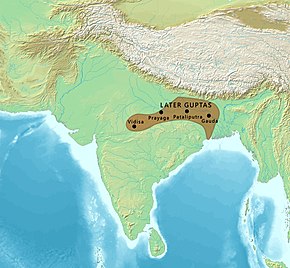
Back Guptes Posteriors Catalan Dinastía Gupta Oriental Spanish गुप्तवंश (मागध अथवा मालव वंश) Hindi ಉತ್ತರ ಗುಪ್ತ ರಾಜವಂಶ Kannada 후굽타 왕조 Korean Later Gupta dynasty SIMPLE பிற்கால குப்தர் வம்சம் Tamil
Later Gupta dynasty | |||||||||||||||
|---|---|---|---|---|---|---|---|---|---|---|---|---|---|---|---|
| c. 6th century CE–c. 8th century CE | |||||||||||||||
"Swordsman type" gold coin of Mahasenagupta from the 6th century CE. On the obverse, the King is shown holding a sword in his left hand. On the reverse, a Goddess is shown seated in a lotus pose.[1]
| |||||||||||||||
The later Gupta dynasty at its zenith, and its neighbours.[2] | |||||||||||||||
| Capital | Pataliputra | ||||||||||||||
| Religion | |||||||||||||||
| Government | Monarchy | ||||||||||||||
| History | |||||||||||||||
• Established | c. 6th century CE | ||||||||||||||
• Disestablished | c. 8th century CE | ||||||||||||||
| |||||||||||||||
The Later Gupta dynasty, also known as the Later Guptas of Magadha, were the rulers of Magadha and Malwa from the 6th to 8th centuries CE. The Later Guptas emerged after the disintegration of the Imperial Guptas as the rulers of Magadha and Malwa however, there is no evidence to connect the two dynasties and the Later Guptas may have adopted the -gupta suffix to link themselves the Imperial Guptas.[3]
There are several important sources of information regarding the Later Guptas including two epigraphs, the Aphsad inscription of Ādityasena, which sets out the genealogy of the ruling family from Kṛṣṇagupta to Ādityasena, and the Deo Baranark inscription of Jīvitagupta II. The Harshacharita of Bāṇabhaṭṭa is also an important source of information as are the records of the Chinese pilgrims Xuanzang and Yijing which also mentions them. The Gaudavaho of Vākpatirāja refers to the victory of King Yashovarman of the Varman dynasty against the king of Magadha, with the scholarly consensus being that this is a reference to Jīvitagupta II.[4][5]
- ^ Kumar, Sanjeev (2024). Treasures of the Gupta Empire: A Numismatic History of the Golden Age of India. Archaeopress. pp. 491–514. doi:10.2307/jj.17610828. ISBN 9781803277967.
- ^ Schwartzberg, Joseph E. (1978). A Historical atlas of South Asia. Chicago: University of Chicago Press. p. 145, map XIV.1 (i). ISBN 0226742210.
- ^ Karl J. Schmidt 2015, p. 26.
- ^ Ghosh, Suchandra (2022). "Later Guptas". The Encyclopedia of Ancient History: Asia and Africa: 1–2. doi:10.1002/9781119399919.eahaa00571. ISBN 978-1-119-39991-9.
- ^ Sailendra Nath Sen 1999, p. 246.
!["Swordsman type" gold coin of Mahasenagupta from the 6th century CE. On the obverse, the King is shown holding a sword in his left hand. On the reverse, a Goddess is shown seated in a lotus pose.[1] of Later Gupta dynasty](http://upload.wikimedia.org/wikipedia/commons/thumb/c/c5/Swordsman_type_coinage_of_Mahasenagupta_of_the_Later_Gupta_dynasty.png/300px-Swordsman_type_coinage_of_Mahasenagupta_of_the_Later_Gupta_dynasty.png)

